- Home
- The Spring Garden
- Spring Vines
Twine This! Spring Vines
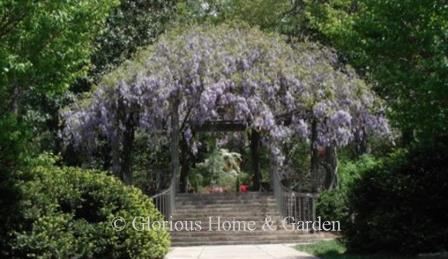 Wisteria arbor at Sarah P. Duke Gardens, Durham, N.C.
Wisteria arbor at Sarah P. Duke Gardens, Durham, N.C.Spring vines are often overlooked as a feature in garden. There is nothing better to create vertical interest and charm. They can be used in many creative ways to cover walls, fences, pergolas, or arbors, they can be allowed to twine through shrubbery or displayed on a trellis or tuteur.
Actinidia kolomikta, variegated kiwi vine, Zones 4-8. Actinidia kolomitka is a showy deciduous climbing spring vine grown mainly for its variegated leaves which on new growth are pink or sometimes with white on the tips and may extend to the whole leaf. Not well known in this country, it is used quite extensively in the U.K., and the first time one encounters it, the response is “What is that?” A definite attention-getter. The species that produces kiwi fruit is Actinidia deliciosa. A. kolomitka can also produce fruit (not as large as A. deliciosa), but a male and female plant are necessary for pollination.
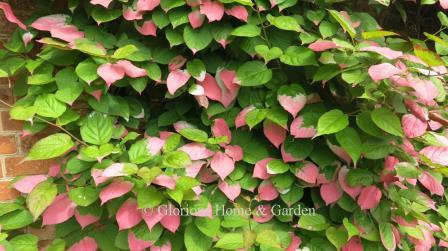 Actinidia kolomitka
Actinidia kolomitkaAkebia quinata, fiveleaf akebia or chocolate vine, Zones 5-8. Chocolate vine is an attractive fast grower, twining enthusiastically over fence, trellis, pergola, or whatever you care to plant it against—therefore careful pruning is required to keep it check. Blooming in early to mid-spring, the fragrant chocolatety-purple flowers appear with the distinctive blue-green five-leaflet leaves. Semi-evergreen in the warmer zones, deciduous further north.
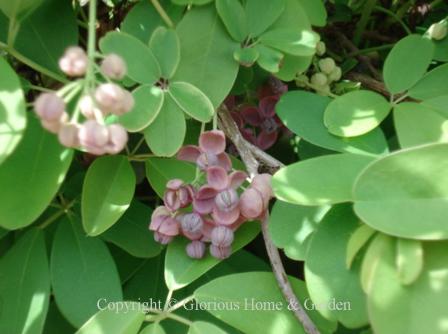 Akebia quinata
Akebia quinataClematis: 'The Queen of Spring Vines
Clematis is the aristocrat of spring vines, and some of them continue throughout the summer even into fall. There are so many beautiful ones, in a variety of colors and forms to suit any garden from spectacular large-flowered forms to massive ones smothered in blooms, to smaller, dainty bell-shaped ones. There are evergreen and deciduous ones, vining and clump-forming ones. For the clump-forming type, see the Spring Perennials page.
Clematis is easy to grow provided you adhere to a few basic rules. The old truism that clematis “like their heads in the sun, and their feet in the shade” is important to keep in mind by planting in a sunny location, with shade during the hottest part of the day, especially in hot summer areas, and mulching the roots well to keep cool and moist.
It is important to know which of three pruning groups your clematis belongs to.
Pruning Group 1: Blooms on last year’s new wood. Pruning not required except to remove dead wood, or if necessary to keep in control, which should be done immediately after flowering.
Pruning Group 2 : Flowers only on old wood (previous year). Prune immediately after spring flowering.
Pruning Group 3: Flowers only on new wood. Can be cut to the ground in fall or spring.
Clematis armandii, Armand’s clematis, Zones 7-9. This clematis is easily identifiable by its long, narrow, dark green evergreen leaves. Very fragrant creamy white flowers cover the vine in spring. Handsome even out of flower, this clematis, which can grow to 25’ but is easily controlled, looks superb trained on a wall, trellis, doorway, or fence. Pruning Group 1.
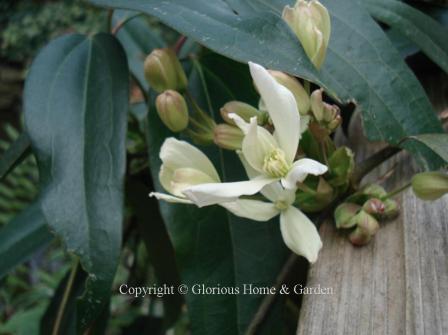 Clematis armandii
Clematis armandiiClematis hybrids, Zones 4-8. These are the large-flowered varieties that come to mind when one thinks of clematis. Hybridizers have used various clematis species including C. jackmanii, C. patens, and C. viticella, among others to create these large, beautiful blooms. Available in singles or doubles, and in shades from white, pink, blue, purple and red, to bi-colors, these beauties deserve a place in every garden. Blooming heavily in spring, some rebloom in late summer into fall. Pruning Group 2.
Boulevard® ‘Alaina™,’ is bright pink with darker center bars that soften with age. A compact grower to 4-5.’
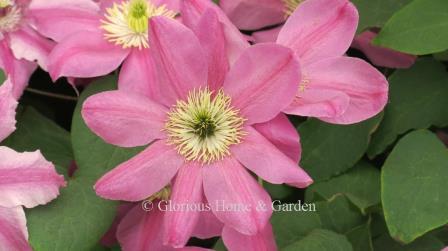 Boulevard® ‘Alaina™
Boulevard® ‘Alaina™‘Clair de Lune’ is a beautiful large-flowered clematis named so because it seems to reflect the light of the moon. Nearly white, or a very pale lavender with darker ruffled lavender edges and purple stamens.
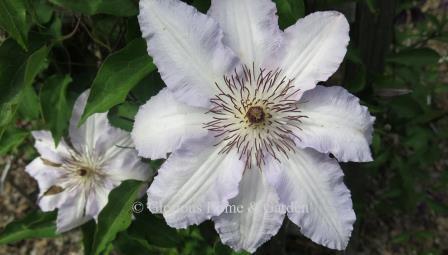 Clematis 'Clair de Lune'
Clematis 'Clair de Lune'‘Dr. Ruppel’ has large pale pink flowers with darker pink center bars and slightly ruffled edges. A vigorous grower from 6 to 10,’ it blooms heavily in spring and puts on a second show in late summer into fall.
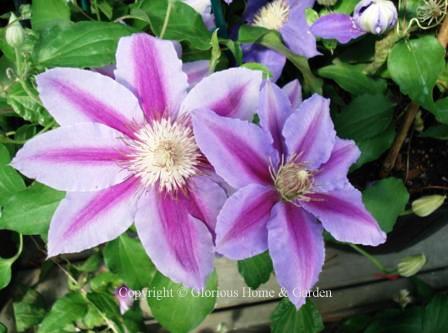 Clematis 'Dr. Ruppel'
Clematis 'Dr. Ruppel'‘Duchess of Edinburgh’ is a lovely double white variety that can grow 8-12’ in height. The first flush of blooms is in spring with a repeat performance in late summer or early fall.
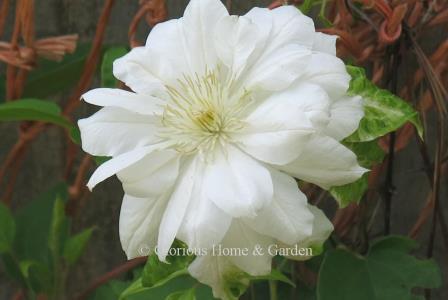 Clematis 'Duchess of Edinburgh'
Clematis 'Duchess of Edinburgh'‘Fairy Blue,’ also called ‘Crystal Fountain™,’ is a ’lovely violet blue with silvery-violet petaloids which seem to cascade over the flower as they mature. Reblooms in late summer to fall.
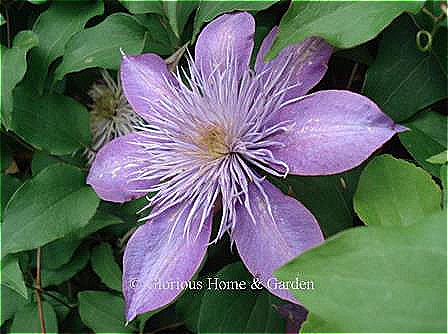 Clematis 'Fairy Blue,' also called ‘Crystal Fountain™’
Clematis 'Fairy Blue,' also called ‘Crystal Fountain™’‘H. F. Young’ has large soft lavender-blue flowers in spring on a vine that grows 8 to 10.’
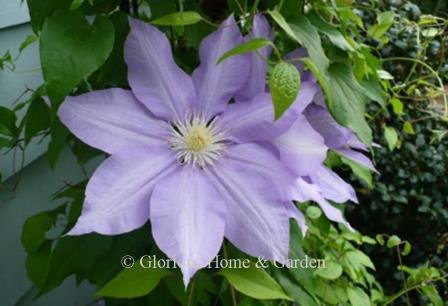 Clematis 'H. F. Young'
Clematis 'H. F. Young'‘Miss Bateman’ is a large-flowered clematis blooming in spring in pure white with set off with purple stamens. Grow ‘Miss Bateman’ on trellises, arbors, fences, or even through shrubs or small trees. 6-8 ft.
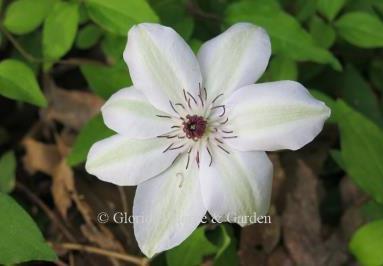 Clematis x patens 'Miss Bateman'
Clematis x patens 'Miss Bateman'‘Nelly Moser’ is a deservedly popular spring vine with its pale pink flowers that fade to near white, accented with deeper pink center bars and purple stamens. The flowers are followed by swirling curvilinear seedpods. “Nelly’s” size of 8-10’ makes her very versatile for almost any situation—on tuteurs, arbors, or fences, especially in small gardens.
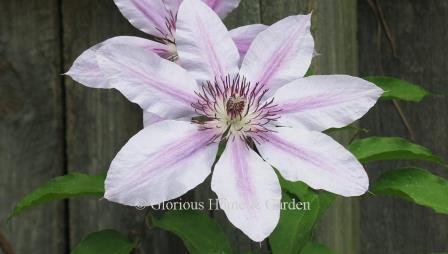 Clematis 'Nelly Moser'
Clematis 'Nelly Moser'‘Rebecca’ boasts some of the largest—and reddest—flowers yet developed in clematis. Petals like velvet, contrasted with light stamens make her a knockout. ‘Rebecca’ grows to a height of 6-8’ making it ideal for trellises and tuteurs, even containers.
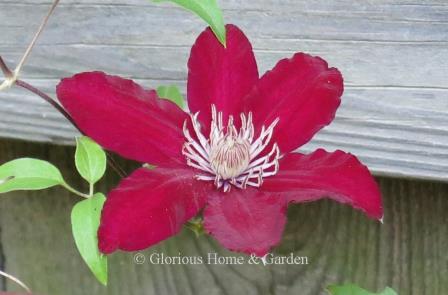 Clematis 'Rebecca'
Clematis 'Rebecca'Boulevard® ‘Samaritan Jo™’ has single to semi-double flowers in soft white with purple edges and grows to a compact size of about 3 to 4’ making it ideal for smaller gardens or containers. The first flush of blooms in the springs is followed by an encore show in t he late summer to fall.
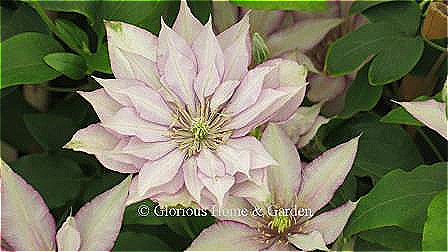 Clematis Boulevard® 'Samaritan Jo'
Clematis Boulevard® 'Samaritan Jo'Clematis montana, anemone or Himalayan clematis, Zones 5-9. Clematis montana is a vigorous woody deciduous spring vine that can reach 20-30.’ The four-petaled flowers occur in spring (late March to late April in my 8a garden), smothering the vine in soft pink to white. Superb for training on walls, pergolas, arbors, fences—even through trees. Pruning Group 1.
 Clematis montana var. rubens
Clematis montana var. rubensClematis ‘Rooguchi,’ solitary clematis, Zones 4-8. Clematis ‘Rooguchi’ is a hybrid between C. integrifolia and C. x durandii. It has charming small-bell-shaped purple flowers edged in lavender. As ‘Rooguchi’ grows to about 6,’ it is excellent for use on tuteurs or trellises, or for growing through roses and other shrubs in a sunny to part-shade location. Blooms in late spring into fall. Pruning Group 3.
 Clematis 'Rooguchi'
Clematis 'Rooguchi'Gelsemium sempervirens, Carolina jessamine, Zones 6-9. Carolina jessamine begins blooming in February into April Bright yellow five-petaled blooms appear over a long period and brighten the grayest day. A well-behaved vine generally, it reaches about 12’ (though if allowed it can climb high into trees).
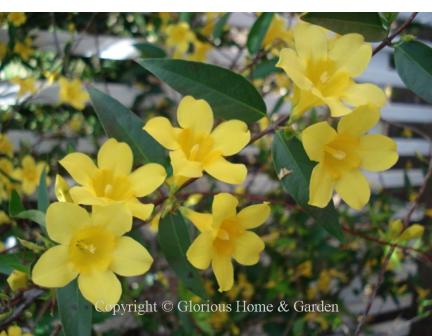 Gelsemium sempervirens, Carolina jessamine
Gelsemium sempervirens, Carolina jessamineLonicera - Honeysuckle
Lonicera x heckrottii, goldflame or everlasting honeysuckle, Zones 5-9. ‘Goldflame’ honeysuckle is a semi-evergreen woody spring vine with flowers of a pinkish-red exterior and creamy interior that blooms in spring and continues into summer and fall. Growing to about 10-20,’ it is a prettier and better-behaved garden subject than the invasive Japanese honeysuckle (Lonicera japonica) that runs rampant through much of the South.
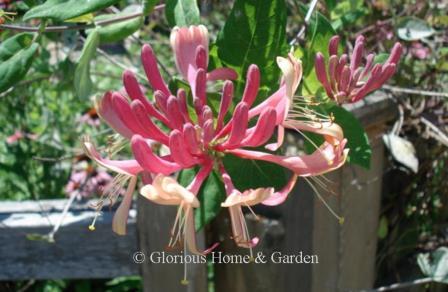 Lonicera x heckrotti 'Goldflame'
Lonicera x heckrotti 'Goldflame'Lonicera periclymenum, woodbine honeysuckle, Zones 4-9. ‘Peaches and Cream’ is a compact, non-invasive, evergreen cultivar that grows to 5 to 6’ making it a great subject for home gardens, containers, tuteurs, trellises, or allowed to trail through a perennial and mixed shrub border. The flowers are pink with a white interior, are fragrant, and bloom from spring through summer.
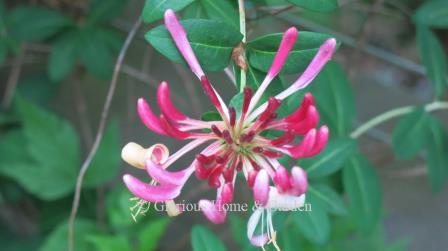 Lonicera periclymenum 'Peaches and Cream'
Lonicera periclymenum 'Peaches and Cream'Lonicera sempervirens, trumpet honeysuckle, Zones 4-9. This native deciduous to semi-evergreen twining honeysuckle occurs primarily in the southeastern U.S. It is not invasive, and thus is a much better garden subject than Japanese honeysuckle. Clusters of long tubular flowers occur on the tips of shoots in spring and are very attractive to hummingbirds and butterflies Some cultivars include ‘Alabama Crimson,’ red; ‘John Clayton,’ yellow; ‘Magnifica,’ red-orange; and 'Major Wheeler,' red.
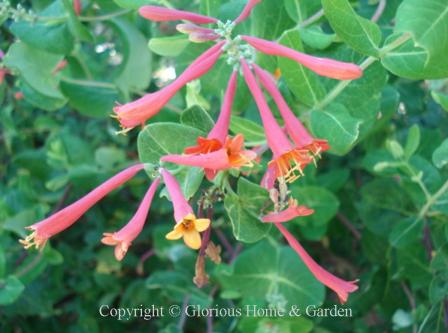 Lonicera sempervirens 'Alabama Crimson'
Lonicera sempervirens 'Alabama Crimson'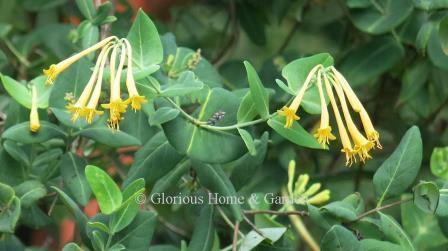 Lonicera sempervirens 'John Clayton'
Lonicera sempervirens 'John Clayton' Lonicera sempervirens 'Major Wheeler'
Lonicera sempervirens 'Major Wheeler'Trachelospermum jasminoides, Confederate or star jasmine, Zones 7-10. A very vigorous and enthusiastic spring vine that will soon wear out its welcome if not controlled, as it will reach out and engulf anything around--including chair legs, bird feeders and downspouts as I learned from personal experience. But that said, it is certainly worth growing for its deliciously fragrant white flowers in spring if given proper (and strong) support such as a pergola or trellis.
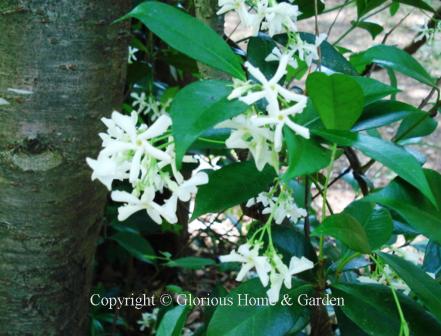 Trachelospermum jasminoides, Confederate or star jasmine
Trachelospermum jasminoides, Confederate or star jasmineVinca major, large periwinkle, Zones 6-9. An evergreen ground cover with glossy foliage and blue flowers, this spring vine is larger in flower and leaf than Vinca minor below. Does well in sun or shade and is useful to cover large areas under trees or on slopes.
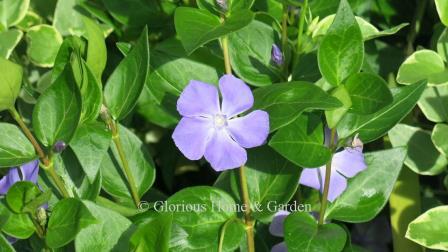 Vinca major, large periwinkle
Vinca major, large periwinkleVinca minor, common periwinkle, Zones 4-9. A good evergreen ground cover for shady areas, Vinca minor has bluish-purple flowers. ‘Ralph Shugert’ is a nice cultivar with variegated dark green foliage edged with cream, and darker blue flowers than the species.
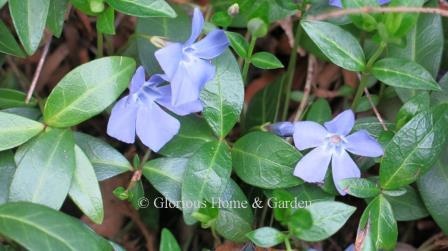 Vinca minor, common periwinkle
Vinca minor, common periwinkle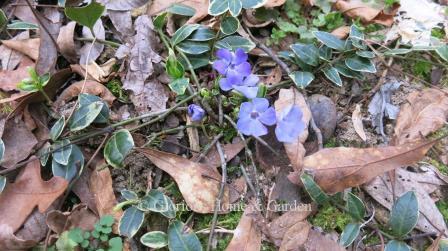 Vinca minor 'Ralph Shugert'
Vinca minor 'Ralph Shugert'Wisteria
Wisteria floribunda, Japanese wisteria, Zones 5-9. Japanese wisteria is a gorgeous deciduous vine for spectacular floral effect in April into May. A very vigorous spring vine, wisteria will form a tree-like trunk over time and requires a very strong support for vines that can reach 30’ or more, and require careful pruning. Pruning reaches an art form with vines trained into tree-like shapes, formed into tunnels on pergolas, covering stone or brick walls, or arching over doorways. Available in colors of white, pink, rose, lavender, and violet, the long, fragrant racemes give a waterfall effect. Some varieties are incredibly beautiful with racemes as long as 3-to-4 feet in length, but more commonly 12-18”. It is interesting that the vine twines clockwise as opposed to W. frutescens and W. sinensis below. This is the wisteria that has escaped cultivation and can be seen climbing high into trees in the South and blooming in cascades of purple in spring. Generally not for the small home gardener, but it is fun to see magnificent specimens in spring. Some places to see great examples of wisteria properly pruned include Andalusia in Bensalem, Pennsylvania; Biltmore Estate in Asheville, North Carolina, Chanticleer, Wayne, Pennsylvania; Longwood Gardens in Kennett Square, Pennsylvania (the purple variety below), Sarah P. Duke Gardens in Durham, North Carolina; Hampton Court Palace, Hidcote Manor Gardens, Iford Manor, and Sissinghurst Castle Gardens (‘Alba’ below) in England, among others.
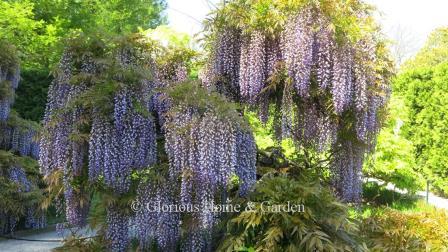 Wisteria floribunda, Japanese wisteria
Wisteria floribunda, Japanese wisteria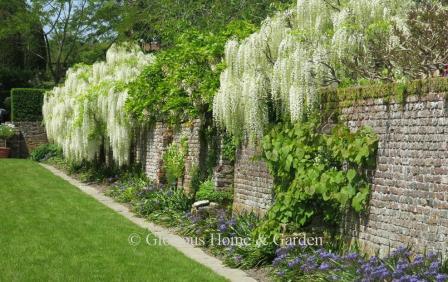 Wisteria floribunda 'Alba'
Wisteria floribunda 'Alba'Wisteria frutescens, American wisteria, Zones 5-9. Our native wisteria occurs in the southeast along stream banks and other moist areas and is much less aggressive than W. floribunda or W. sinensis, though it can reach 30.’ It blooms a little later (late spring) than the Japanese and Chinese species, and may repeat in the summer. The flower clusters are typically purple with a yellow blotch, and are smaller and shorter than the Chinese and Japanese species occurring after the leaves have appeared. The vines twine counter-clockwise like W. sinensis. This wisteria is adaptable to the home garden for pergolas, trellises, and arbors, is easier to maintain and non-invasive. A popular variety is ‘Amethyst Falls,’ lavender-blue.
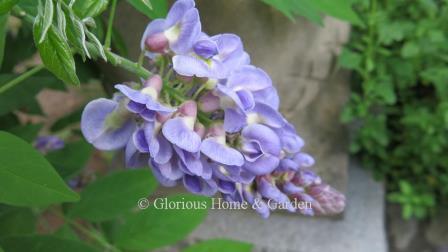 Wisteria frutescens, American wisteria
Wisteria frutescens, American wisteriaWisteria sinensis, Chinese wisteria, Zones 5-9. Chinese wisteria is another imported species that has escaped gardens, but not to the extent of W. floribunda. It is a beautiful counter-clockwise twining vine with long pendulous racemes of flowers in spring in colors of blue, purple, pink, or white. Grow in full sun on very strong supports and prune vigorously to keep in control.
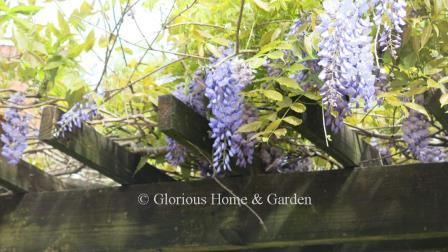 Wisteria sinensis, Chinese wisteria
Wisteria sinensis, Chinese wisteria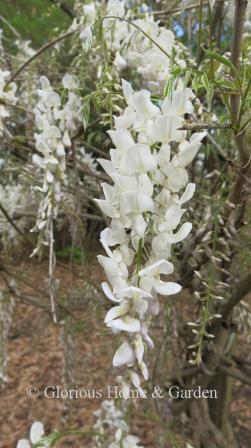 Wisteria sinensis 'Jako'
Wisteria sinensis 'Jako'Plant of the Month
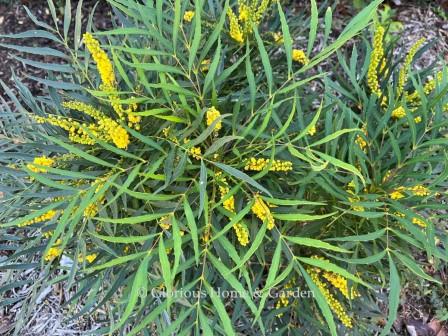
Mahonia eurybracteata
'Soft Caress'
Updated new USDA Plant Hardiness Zone Map 2023.